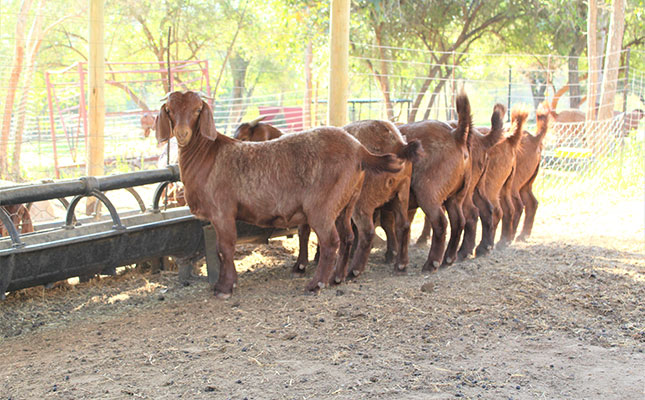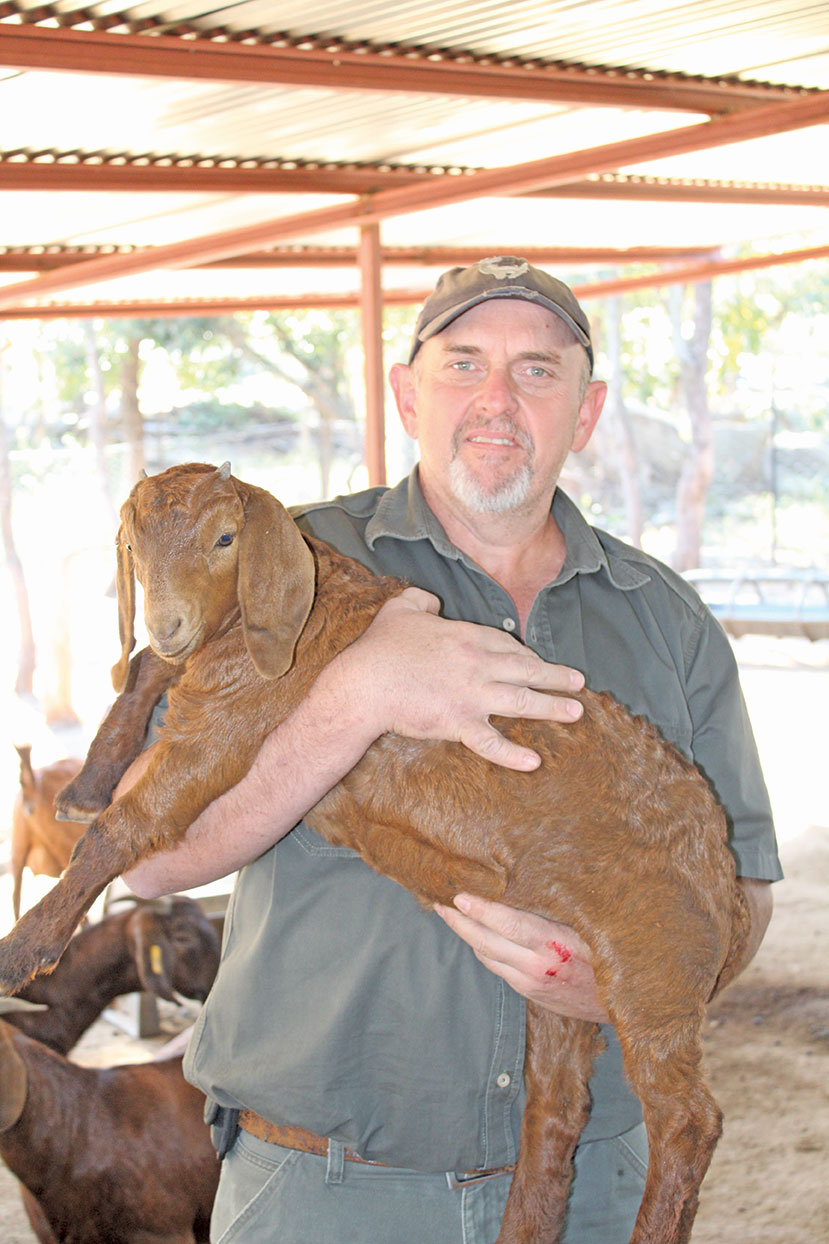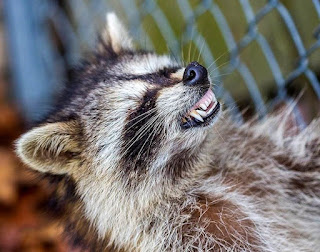Kalahari Red goats: A solid reputation built on great genetics - Farmer's Weekly SA

Photo: Lindi Botha
As the saying goes, it takes years to build a reputation, but only minutes to lose it. In the case of a stud breeder, one inferior gene can diminish the quality of an entire herd and erase all the hard work of previous years.
While Eddie Goosen, owner of Maggiesdal Kalahari Red Goat Stud near Mbombela, Mpumalanga, is relatively new to the business, he understands the importance of laying a strong genetic foundation at the start.
"Developing a successful stud farm takes time, because you're building not just the quality of your herd, but also your reputation. And without a good reputation, you can't really make a success of stud farming, because people want to know that they're getting what they paid for. There needs to be a system of genetic traceability in place that you can trust," he explains.

Although not new to farming, Goosen started building his Kalahari Red stud just two years ago. The gleaming auburn coats of these goats caught his eye at livestock shows, and when he was made an offer for his entire Dexter cattle herd, he decided to switch species. Today, he has a herd of 90 ewes and two rams.
"I purchased my first ram from champion breeder Josef Kleynhans. My second, bought from Anton Bothma, is the son of a world champion Kalahari Red, and a large part of my herd is progeny from that ram. I bought the stud ram I'm using at the moment from Albie Horn."
Boosting the name of a beginner stud
Goosen says that buying rams from champion breeders is vital, as it lends credibility to his own stud.
"Besides the quality you get, you're also able to build your reputation based on the calibre of animals you keep and where they come from.
"My Maggiesdal stud is still relatively unknown and farmers might not want to pay higher prices for my animals, but the fact that my herd is the progeny of animals bred by the Kleynhanses and Bothmas of the goat industry immediately gives gravitas to my goats. This makes it easier to fetch higher prices."
Strict selection
Goosen places the rams permanently with the ewes and allows natural breeding to take place. Although the kidding season starts in May, he is not limited to a specific breeding season as the goats are farmed intensively.
However, he seeks to expand his herd as quickly as possible, so aims for three kidding seasons in two years. He achieves a kidding percentage of 150%, with weaning weights of 25kg and 20kg for rams and ewes respectively. All rams are sold when they reach 50kg, along with any female animals that do not meet the selection criteria.
Goosen selects against white colouring. He also looks for good build, and uniform horns that are bent close to the head. In ewes, he aims for good maternal instincts, paying particular attention to good milk quality and the increased likelihood of producing twins.
Kids should reach 50kg by the time they are between eight months and one year of age.
First-time mothers are kept in a separate camp closer to the house so that Goosen can watch them more easily and ensure they and their kids remain in good condition.
"Their udders often become blocked by a hard plug that forms on the tip and the kids can't drink," he explains.
"The udders just need a hard squeeze to get the plug out, and then the milk flows. It's important that the kids get the colostrum and continue to drink enough from their mothers. If I see a kid that needs a bit of a boost, I feed it extra milk from ewes whose kids have been weaned. We milk these ewes so they don't get mastitis, and then freeze the milk for such occasions."
Keeping the herd healthy requires vigilance. Goosen ensures that each goat in his herd is observed at least twice a day so that any problems can be spotted quickly and swift action taken if required.
Herd health
Despite being on the Lowveld, Goosen's Kalahari Red goat stud experiences few problems with ticks and other diseases. Winter temperatures dip to a minimum of 8°C, with the occasional -2°C in an extreme cold front. In summer, temperatures can reach a maximum of 40°C.
The high humidity, however, does contribute to an increased occurrence of caseous lymphadenitis, a contagious bacterial disease that manifests as abscesses of peripheral or internal lymph nodes and organs.
"It's a general problem with goats, but it seems to be very prevalent here. Once it's in your herd, it spreads quickly. Annual vaccination helps to [control] it, but because it's so contagious, I'm very careful when releasing the discharge from the lumps, as it can get into the soil and reinfect the goats."
Other diseases are kept in check with regular inoculations and, in summer, the goats are dipped once a week against ticks.
"I was initially worried about heartwater and made a point of buying in animals from heartwater areas so they would be more resistant. But I've never really had a problem and have never lost a goat to heartwater.
"It's important, though, to expose the goats to heartwater as well as using vaccines, so they can build up resistance and become immune."
Pulpy kidney is another problem disease, and to tackle it Goosen focuses on feed as well as inoculation.
"We vaccinate against pulpy kidney and have a feed programme worked out specifically for our herd. The kids must be vaccinated against the disease within the first week and the ewes once a year."
Since the herd grazes 20ha of natural veld during the day, the camps must be kept free of Lantana camara, a notorious weed that is toxic to goats, affecting their kidneys and sight.
"This is really a massive problem. There's a joke in our family that if they're searching for me they'll find me in the bush, where I''ll be chopping down Lantana. It takes up a lot of time!"
In addition to the natural veld, the goats also graze 2ha of pasture planted to Brazseed.
Grazing makes up only 30% of their food, however; the balance is provided by a feed mixture comprising maize, sheep fat, lucerne and molasses. The herd is fed twice a day during kidding season and once a day when not in production.
"I don't believe it's possible to reach the goal of having a superior stud without the right nutrition and additional feeding," says Goosen.
"Nutrition affects fertility and weaning percentage, and the sooner the kids are
weaned, the sooner the ewes can get back to good condition and kid again.
"The ewes also kid more easily when they're in good condition; if you skimp on nutrition, you'll see it in the kidding."
Traceability
Stud breeders aim to breed the perfect animal, so knowing which genetics are already in the gene pool and which are missing is crucial. Goosen therefore takes care when selecting animals, paying close attention to the full pedigree as specified by SA Studbook.
"I don't buy animals that are not registered with SA Studbook," he says. "It's important to know the history of the animal, which characteristics you're dealing with, and which genes need to be bred in.
"The Kalahari Red gene pool is rather small, so there's a risk of inbreeding. This is why traceability is so important.
"SA Studbook indicates the percentage that the animal has already been inbred. When you're buying an animal, you need to know which genetic lines you can breed it with, otherwise you increase the inbreeding."
Goosen believes that in the future it will be the norm for all stud animals to be registered with SA Studbook, particularly as registered animals fetch a premium because of their traceability.
He learnt the value of SA Studbook the hard way. After purchasing a number of animals from two farmers in different areas, he discovered long afterwards, via SA Studbook, that all these animals had, in fact, originated from one farm. By then, unfortunately, they had already been mated and this had resulted in inbreeding.
"It was an expensive mistake. It's so important to do your research and select animals with care."
Goosen notes that the breed is becoming more sought after and this is resulting in higher prices prices on the hoof than on the meat market.
Email Eddie Goosen at [email protected].


Comments
Post a Comment